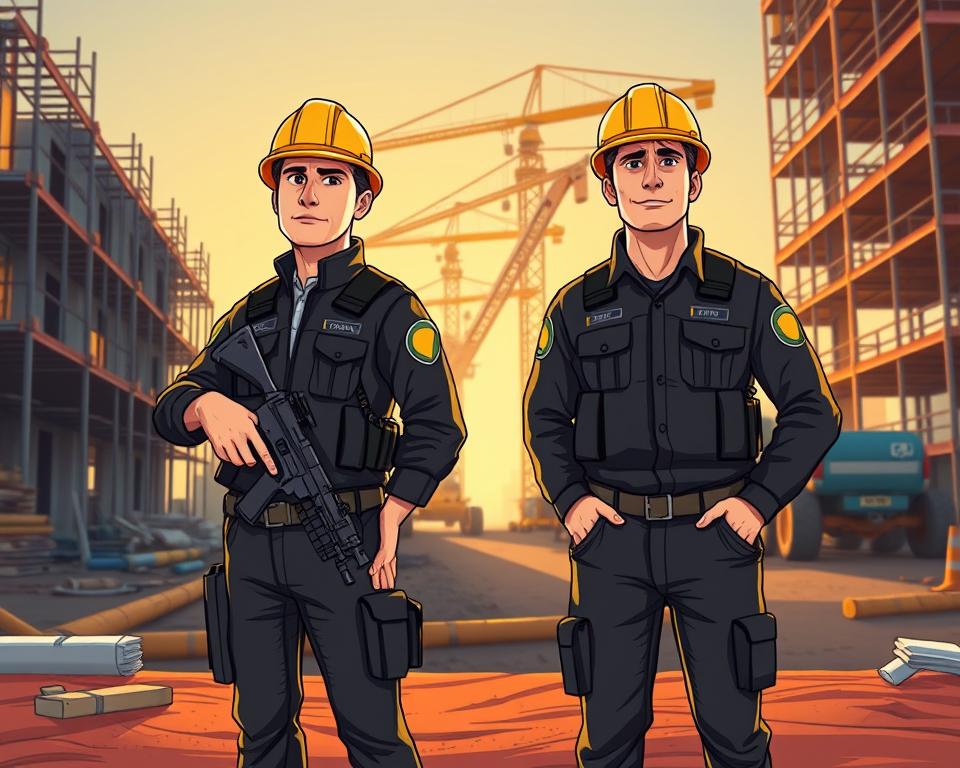Improve Your Construction Site Safety Immediately
Imagine stepping onto your job site later just to discover critical tools gone and even equipment items vandalized. How soon could delays of this kind disrupt deadlines as well as budgets? Construction ventures regularly house expensive equipment across unsecured zones, making them vulnerable targets. Without proper safeguards, you’re not just putting at risk supplies—you’re jeopardizing everything your crew has constructed.
Burglars often prey on locations lacking extensive monitoring, mainly during off-hours. Stealing mobile equipment alone cost businesses businesses millions each year. Setbacks caused by replacing taken items or repairing damage create stress and unexpected expenses. Thankfully: proactive apartment building security planning will transform risks into assets.
Divine Protection Services specializes in tailored protection strategies for dynamic environments. Its tactics integrate state-of-the-art tech with field experience to help keep your investments protected. In the following sections, you’ll discover concrete measures to deter theft, control access, plus continue progress without sacrificing security.
Ready to change how you protect your site? Let’s review practical solutions that balance efficiency with ironclad protection.
Comprehending the Essentials of Job Site Security
Every year, unsecured workspaces experience millions of dollars in losses due to preventable incidents. Unsecured zones containing valuable tools and machinery invite criminal activity, chiefly at night. Let’s break down the main challenges and why early action matters.

Where Security Gaps Appear
Open storage containers, unattended materials, plus dimly lit areas become easy prey. Industry data indicates a 40% surge in theft during summer when construction ramps up. Frequent security gaps are:
- Portable generators left overnight
- Copper wiring stored in visible areas
- Lacking perimeter barriers
Expenses Exceeding Stolen Goods
One missing excavator could push project timelines back weeks while insurance claims process. Vandalism repairs often exceed $5,000 per incident, draining budgets fast. Workers end up on overtime to compensate—doubling the productivity loss.
Simple fixes like motion-activated lights reduce after-hours breaches by 60%, according to safety studies. Using obvious cameras alongside locked gates deters intruders by indicating high risk.
Addressing these basics first, you create a strong foundation for advanced strategies. Up next: customizing solutions to fit your site’s specific demands.
Determining Your Site’s Specific Security Needs
What causes different sites to have different vulnerabilities? Each job site has unique characteristics that determine its risks. A thorough evaluation of your property’s layout, workflow, and assets is the first step toward building defenses that actually work.
Identifying Site-Specific Vulnerabilities
get a layout of high-traffic zones and material storage points. Do costly tools sit in dark corners? Is fencing missing near public thoroughfares? A safety report states blind spots in busy zones are responsible for 35% of nighttime thefts. Fixing these issues promptly avoids future problems.
Look at how storage methods impact security. Example: Copper wiring stored beside temporary entrances draws unwanted attention. Similarly, portable gear left exposed in fields invites theft. Custom approaches may involve:
- Adjusting lighting based on work hours
- Assigning secure storage for expensive gear
- Changing access paths to reduce risk
A bespoke safety strategy shields your workforce and assets. Proactive measures reduce delays and keep budgets intact. Addressing your site’s particular requirements crafts a security system that grows as the work progresses.
Implementing Effective Security Measures
Bright perimeter lights serve as more than illumination—they’re the first line of defense. Here, we dive into tangible improvements marrying technology and clever layouts to safeguard your assets.
Lighting That Works Smarter
Lights triggered by motion wipe out hiding spots for unauthorized visitors. A contractor saw a 75% drop in nocturnal security breaches after adding them around storage sections. Pair them with:
- Sun-powered luminaires for far-flung spots
- Scheduling that aligns lighting with active hours
- All-weather fixtures for lasting performance
Barriers That Do More
Sturdy fencing does more than mark boundaries—it slows down unauthorized entry. A case study showed chain-link barriers with anti-climb features cut trespassing attempts by 60%. Opt for barrier materials which:
- Resist vehicle collisions
- Allow visibility for patrols
- Have lockable entryways
Visible signs serve as silent sentinels. “No Trespassing” warnings paired with alarm system decals make intruders think twice. One team reported zero thefts after adding multilingual signs near entryways.
Current alarm solutions send live notifications to smartphones. Pair them with motion detectors and intelligent locks for multi-tiered defense. Have your team conduct weekly inspections to verify device functionality—this little bit of time saves major trouble down the line.
Putting these steps in place today builds a safer space for crews and gear. Regular updates keep your strategy effective as projects evolve.
Harnessing Technology for Site Protection
The era of depending only on locks and guards is over. Current tech merges innovation with functionality, forming a safeguard that operates while you’re away. Let us review how advanced tech tools defend assets while maintaining workflow efficiency.
Round-the-Clock Monitoring
Today’s cameras not only capture footage but also analyze it. Combining 4K video and motion sensors enables detection of suspicious actions, like loitering by storage bins after dark. One contractor reduced theft by 82% using systems that send alerts to their phones. Available types are:
- Solar-powered security units for distant areas
- Weather-resistant configurations built for tough environments
- Night-vision infrared features for clear after-dark viewing
Recording nonstop catches every moment, and motion-based modes conserve power. According to a tech report, merging the two approaches halves false alarms.
Advanced Entry, Enhanced Control
Access cards make tracking easy without impeding team speed. Swipe-to-enter setups record everyone’s presence—perfect for handling subs. Perks feature:
- Immediate logging for review
- Off-site access right updates
- Integration with alarm systems
One manager relayed: “We spotted a material delivery mix-up swiftly due to precise equipment shed access logs.” While guards remain important, tech covers basic monitoring, giving them time to patrol sensitive spots.
These tools don’t replace human judgment—they amplify it. By merging tradition with innovation, you build a defense that’s as dynamic as your worksite.
Optimizing Security with Divine Protection Services
How recently did your site’s safety strategy adjust to new threats? Divine Protection Services stands out by treating every location as unique. They kick off with detailed site assessments, tracking risks from material placement to regional crime data. This isn’t cookie-cutter protection—it’s precision.
Advantages of a Collaborative Security Method
Rather than one-size-fits-all fixes, they study your processes and environment. Example: A highway job updated patrol paths reflecting adjacent foot traffic patterns. Outcome: Six straight months without a theft. Their method includes:
- In-person reviews with safety engineering teams
- Bespoke tech integrations (aerial drones plus ground-based sensors)
- Monthly tactic adjustments to match project shifts
Expert Security Personnel and Guarding Strategies
Their guards do more than patrol—they’re skilled in dispute handling and tech integration. Security personnel staved off $12k in damages by detecting suspicious actions at fuel storage. Their layered approach combines:
- 24/7 patrols with randomized schedules
- Live data streams to handheld devices
- Emergency drills for swift response
“We’ve reduced vandalism by 91% on partnered sites,” shares a company lead. Combining human intuition with AI-driven analysis, they craft a forward-thinking shield.
Methods to Stop Unauthorized Access and Theft
What if thieves could stroll right into your workspace unnoticed. Unlocked gates transform construction zones into easy targets for crooks. An unsecured gate or off-schedule delivery can open the door to theft—yet strategic planning thwarts intruders.
Why Timing and Tracking Are Crucial
Plan delivery of materials during staffed hours so crews can monitor. One study found 68% of thefts occur when items sit unattended overnight. Align deliveries with staff availability to ensure someone signs off and stores goods immediately
Creating lockable storage zones with few entry points cuts down on temptation. Set aside locked lockers for valuable equipment with tamper-proof casings. One PM mentioned: “With a set spot for each item, missing gear becomes obvious immediately.”
- Restrict entry points to main gates during non-work hours
- Implement RFID tagging for live equipment monitoring
- Conduct random audits during shifts
Trained personnel play a key role. Security personnel patrolling edges and verifying credentials effectively deter intruders. Integrate guards with digital logging of visitor entry and exit times.
Minor tweaks—such as shifting delivery schedules or moving storage containers—form significant theft barriers. Review protocols weekly to close gaps before they become liabilities. Marrying logistics and protection ensures projects remain on schedule and within budget.
Ensuring Site Safety Through Comprehensive Risk Mitigation
What’s your backup plan if a storm floods your storage yard at midnight? While cameras and fences form your first defense, true protection comes from planning for the unexpected. Merging insurance with emergency plans builds a net that propels projects forward even amid crises.
Insurance Paired with Practical Planning
Proper insurance coverage makes catastrophes manageable setbacks. One project manager dodged $78k in losses post-theft—insurance funded replacements, keeping schedules intact. However, insurance by itself falls short. Combine it with:
- Recorded equipment lists
- 24/7 emergency teams for security breaches
- Climate-tailored evacuation paths
Test your plans quarterly. A Midwestern team averted injuries in a tornado by practicing shelter drills. Their drills lowered evacuation times by 63% against adjacent job sites.
Today’s alarm systems incorporate emergency notifications. When sensors detect flooding or fire, they automatically alert local responders. Such dual capabilities aid in preventing unauthorized access amidst crises.
Refresh risk appraisals as projects change. New phases might require additional coverage or revised escape routes. One safety officer advises: “Consider your emergency plan a living document—it improves with each trial.”
By blending financial safeguards with practiced responses, you protect both assets and teams. Kick off simply: go over policies now and set up your first drill. Readiness now averts chaos later.
Tackling Typical Security Issues on Construction Sites
Site safety extends beyond cameras and barriers—it requires day-to-day problem-solving with effective teamwork. Staff changes, shifting schedules, and evolving layouts can strain even the best plans. A contractor confided: “We rotated through three security teams in a month—keeping consistent seemed unattainable.”
Managing Guards and Everyday Security Routines
High turnover rates make training and communication tough. Simplified checklists assist new hires in rapidly understanding patrol paths and reporting procedures. For instance, routine site walks with photo logs reduced outstanding issues by 45% on a Texas high-rise job.
Using RFID tagging for equipment tracking cuts down losses. Use them alongside lockable storage zones for items such as power tools. Visible signage designating restricted zones further deters casual intruders. One Florida crew experienced a 30% decline in thefts by posting multi-language alerts near material stacks.
Pressure to meet deadlines often compels quick decisions. One solution? Pre-scheduled access logs for deliveries and subcontractors. This balances tight deadlines with controlled entry points. Weekly audits of storage trailers and fuel tanks add another layer of oversight without slowing work.
Job sites evolve rapidly—what was storage yesterday could be a concrete pour area tomorrow. Routine crew huddles guarantee everyone is aware of protocol changes. A manager observed: “Discussing security updates in safety meetings makes compliance pick up organically.” Small adjustments keep protection agile as the job evolves.
Sustaining Long-Term Security Through Best Practices
Steadiness is what turns quick fixes into lasting protection. Think of your safety plan as a daily habit—small, intentional actions add up to unshakable results. Regular checks and adaptive strategies keep your workspace secure through every project phase.
Building Accountability Through Routine
Daily walks let teams spot issues before they escalate. A swift scan of boundaries might find a compromised fence panel or a malfunctioning sensor. One project manager discovered a breached container in a morning perimeter check, saving $8k.
Comprehensive logs form documentation that enhances accountability. Note weather impacts, equipment status, and any unusual activity. “Our digital logs uncovered mismatched after-hours deliveries,” reported a safety officer in Arizona.
Merge physical barriers and technology for comprehensive security:
- Upgrade fencing with tamper-proof connectors
- Test alarm systems weekly
- Employ geofence applications to watch off-limits areas
Monthly strategy reviews ensure your approach evolves with the project. A Florida project extended its area and then changed patrol paths to cover added entrances—decreasing blind spots by 70%. Begin now: designate inspection partners, draft basic checklists, and acknowledge progress. A specialist said: “Security is like a marathon—every stride matters.”
Combining Everything for a Safeguarded Construction Site
Your project’s success hinges on more than blueprints and hard hats—it demands layers of protection that adapt to evolving risks. Uniting physical obstructions like solid fencing and advanced alarm systems forms a barrier that dissuades trespassers at all times. Ongoing rounds by skilled security guards supply human supervision, while motion-sensing lighting removes potential hiding spots for thieves.
Blocking unauthorized entry kicks off with straightforward measures: lock up high-value items in dedicated storage spots, change access codes weekly, and mount noticeable cameras by access ways. Evidence indicates areas applying these practices experience 70% less theft and vandalism than unguarded sites.
Divine Protection Services excels at developing customized solutions for variable sites. They combine high-tech devices such as infrared detectors with practical tactics—varying patrol times, multi-language signage, and live alerts for breaches. One client avoided $50k in losses after their system flagged suspicious activity at the perimeter.
Prepared to fortify your protection? Kick off today by examining weak points and arranging a free consultation. By planning ahead and leveraging expert help, you’ll construct more than sites—you’ll gain tranquillity.
Common Inquiries
What are the most common risks to job site safety?
Trespassing, equipment theft, and property damage are primary worries. Wide-open areas, pricey gear, and isolated spots commonly lure thieves. Bad weather and insufficient illumination can exacerbate vulnerabilities.
What steps stop theft outside work hours?
Install motion-sensing lighting, robust perimeter fencing, and clear surveillance signage. Secure high-value items in locked storage containers. Partner with firms like Divine Protection Services for after-hours patrols and real-time alarm monitoring.
What measures are ideal for short-term projects?
Temporary anti-climb fencing, sun-powered cameras with cloud backup, and provisional access codes for crews. Motion detectors in key areas and daily gear inspections keep watch in evolving conditions.
Can automated systems take over guard duties?
Although drones and intelligent cameras boost surveillance, trained guards are still essential. Mixed approaches blending AI-driven analysis and on-site guards, such as verified security services, provide layered safety.
How to regulate access without impeding progress?
Set up RFID tags or biometric scanners for speedy validation. Mark access points clearly and designate separate delivery areas with signage. Schedule material arrivals during active hours to reduce unattended stockpiles.
Does insurance cover stolen materials?
Most insurance policies stipulate proof of appropriate safeguards such as alarm systems or monitored checkpoints. Document all security measures, maintain equipment inventories with serial numbers, and file police reports immediately after incidents.
How regularly should security procedures be reviewed?
Review measures weekly as projects evolve. Emerging stages might warrant repositioning cameras, extending fencing, or revising access rosters. Conduct surprise audits to ensure teams follow protocols consistently.
Which everyday habits boost long-term safety?
Morning briefings to address risks, sunset equipment lock-down routines, and end-of-day perimeter checks. Deploy platforms like SafeSite for live incident tracking and digital recordkeeping of site operations.
Do visible cameras suffice to keep out intruders?
While helpful, combine them with other deterrents. Display “24/7 Surveillance” notices, install gravel walkways to reveal footprints, and switch up guard patrol schedules. In critical areas, deploy visible camera casings with blinking lights along with covert backup cameras.


